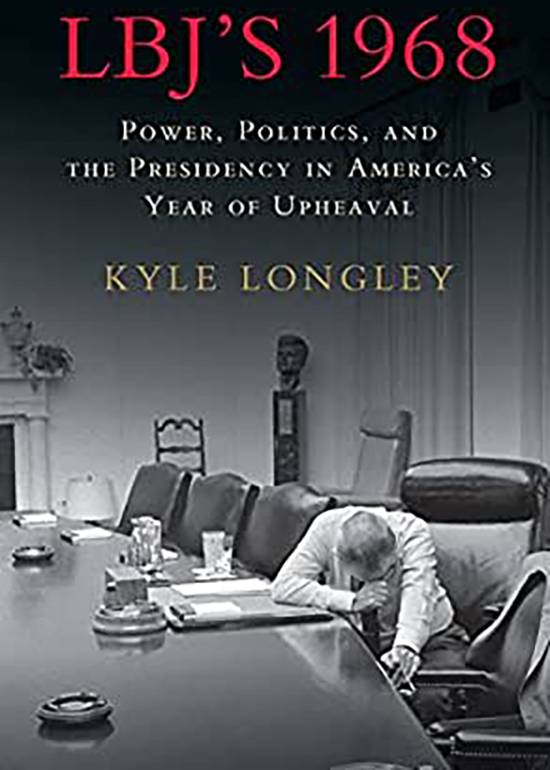
LBJ’s 1968: Power, Politics, and the Presidency in America’s Year of Upheaval
by Kyle Longley
Cambridge: Cambridge University Press, 2018.
361 pp. $29.99 hardcover.
Reviewed by
Mary C. Brennan
“By limiting his scope to LBJ’s perspective during this one year, Longley succeeds in arguing that, as Lady Bird Johnson said in 1963, Johnson was “a good man in an emergency.””
Kyle Longley’s LBJ’s 1968 joins a growing number of monographs examining this significant year. Because 2018 marked the fiftieth anniversary of 1968, historians, journalists, and a wide range of scholars have investigated, dissected, and analyzed the players and events from almost every conceivable angle, adding to the already existing catalogue of books and articles on the subjects. Longley attempts to stand out from the crowd by writing a “microbiography” of President Lyndon Johnson, focusing only on the president’s state of mind, knowledge, and actions during these twelve months. By limiting his scope to LBJ’s perspective during this one year, Longley succeeds in arguing that, as Lady Bird Johnson said in 1963, Johnson was “a good man in an emergency.” As long as the “emergency” did not involve Vietnam or his political legacy, Johnson, Longley shows, could remain calm, ignore knee-jerk reactions and advice, and even find a way to utilize the residual anger, frustration, and fear following a tragedy to accomplish something positive.
Longley is hardly the first to point out that Vietnam was Johnson’s Achilles’ heel, albatross, and blind spot. The author’s organization displays this weakness in shocking contrast to the president’s judicious handling of both the seizure of the Pueblo and the Soviet suppression of the Czechoslovakian uprising. Moreover, because Vietnam colored everything in 1968, Longley connects LBJ’s bungled political moves to the fighting in Southeast Asia. The president’s indecision about running for office and his refusal to cede control of the Democratic National Convention to Hubert Humphrey, the presumptive candidate, are linked in their chapters to the president’s feelings about Vietnam as much as his response to Tet or his handling of the information surrounding the Chennault Affair were.
Vietnam also played a role in another of Longley’s themes: LBJ’s diminishing power following his speech in which he announced his intention not to run for a second term as president. Longley argues for Johnson’s sincere belief that removing himself from the race provided the most favorable circumstances for ending the fighting and securing peace. The author applauds the president’s selfless move but points out that the same decision turned LBJ into a lame duck. Longley blames Johnson’s declining political influence for his failure to achieve his goals following the King and Kennedy assassinations as well as Johnson’s inability to gain approval for his Supreme Court nominations.
While acknowledging LBJ’s weaknesses, Longley’s portrayal of the Texas is mostly positive. The author credits Johnson with the safe return of the Pueblo crew, the even-handed American response to Soviet actions following the Prague Spring, the restraint evidenced during the riots following the assassination of Martin Luther King, Jr. and the legislation sent to congress supporting Fair Housing and gun control. Longley argues that LBJ applied lessons learned earlier in his term to the events of his last year in office. The author’s evidence supports his argument.
There is much to praise in this book. Although historians will not learn much that is new, the general reader will find a few surprises and scholars will appreciate the fascinating perspective. The research is solid; the writing easy-to-read; and the argument easy-to-follow. Most impressively, Longley refrains from mentioning any similarity between the subject of his work and current events until the end of the book. He then draws limited, but apt, connections between 1968 and 2018. In fifty years, we seem not to have come that far.
Born and raised in Cincinnati, Ohio, Mary C. Brennan attended Edgecliff College of Xavier University for her undergraduate degree. She received a Ph.D. from Miami University of Ohio in 1988. Her dissertation on the development of conservatism in modern America was a natural outgrowth of her interest in how politics affect "normal" people. Over the years, she has continued to investigate conservative politics in its various manifestations. Turning Right in the Sixties (UNC Press, 1995) evolved from her dissertation and examined the conservative "capture" of the GOP through the Goldwater campaign. Since then, she has focused on women's roles within conservatism in general and the anticommunist movement in particular. Her book Wives, Mothers, and the Red Menace, (Colorado 2008) evolved from her curiosity about Joe McCarthy’s wife. Her most recent monograph, Pat Nixon: Embattled First Lady, (2011) appeared as part of the Modern First Ladies Series published by the University Press of Kansas.
In 1990, Brennan joined the History faculty at then Southwest Texas State University. During her tenure in San Marcos, she has served as both undergraduate and graduate advisor as well as College of Liberal Arts representative on the Faculty Senate for seven years. In 2007, she won the Mariel Muir Mentoring Award. In 2011, she became chair of the department of history, and in 2017 became dean of the College of Liberal Arts.
